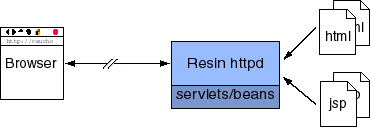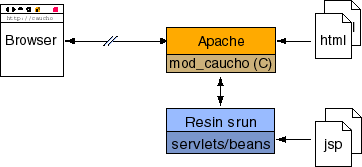Quick Start for the Impatient
The Resin web server starts listening to HTTP requests on port 8080 and listens on port 6800 for load balancer or cluster messages. Resin can then be used for development or evaluation. The steps are:
- Install JDK 1.5 or later.
- On Unix, set the JAVA_HOME variable or link /usr/java to the java home.
- On Windows, check to make sure the JDK installation sets JAVA_HOME correctly.
- unzip/untar the Resin download. It will unzip into resin-3.1.0/.
- resin-3.1.0 is resin.home, the location of the Resin distribution.
- For now, it is also resin.root, the location of your content. Soon, you will want to move resin.root to something like .
- On Unix, execute use ./configure; make; make install
- Start
- Browse
http://localhost:8080
Adding Content
Once you've made sure Resin is working, you'll want to add some content to the default web site:
- Add PHP files like .
- The URL in your browser will be
http://localhost:8080/hello.php
- The URL in your browser will be
- Add JSP files like .
- The URL in your browser will be
http://localhost:8080/hello.jsp
- The URL in your browser will be
- Add servlets like
- Create a file to configure the servlet.
- Add .war files like .
- The URL in your browser is
http://localhost:8080/hello
- The URL in your browser is
- Create web-apps directly like The URL in your browser is
http://localhost:8080/hello.- Create a file to configure the 'hello' web application.
Virtual Hosts
You can easily create virtual hosts by creating content in the directory:
- Add a hello.php to
Permanent content locations
Eventually, you'll want to move your content and configuration into a more permanent location:
- Create a permanent resin.root:
- Create
- Virtual hosts go in
- Run
- You can also set <root-directory> in the <cluster> to configure the resin root.
- If needed, modify the Resin configuration in
- You can copy resin.conf to somewhere like
- Run
Running Resin as a daemon
In a deployment environment, Resin will run as a background daemon. The previous steps ran Resin in the foreground, which is convenient for development since the logging output goes to the console. When running as a daemon, Resin detaches from the console and continues running until told to stop.
- Start resin with
- Stop resin with
- Restart resin with
Until you're ready to deploy the server, those are all the steps needed to get started with Resin.
Preconditions
Resin 3.1 needs Java before it can run. It needs JDK 1.5 or a later JDK.
Sun's JDK for Windows, Solaris, and Linux can be found at http://java.sun.com. Sun also has links to some other ports of the JDK.
Resin Web Server
The easiest and fastest Resin configuration uses the Resin as the primary or only web server. This configuration provides a Java HTTP server. We recommend you start with this before trying any other configuration.

The server listens at port 8080 in the default configuration and can be changed to the HTTP port 80 during deployment.
Windows
- Install JDK 1.5 or later.
- Check that the environemnt variable JAVA_HOME is set to the JDK location, e.g. "c:/j2sdk1.5.0_01"
- Unzip resin-3.1.0.zip
- Define the environment variable RESIN_HOME to the location of Resin, for example "c:/resin-3.1.0"
- Execute
- Browse http://localhost:8080
Unix (including MacOS-X)
- Install JDK 1.5 or later and link /usr/java to the Java home or define the environment variable JAVA_HOME.
- tar -vzxf resin-3.1.0.tar.gz
- cd resin-3.1.0
- ./configure
- make
- make install
- Execute
- Browse http://localhost:8080
For more details, see the Resin Web Server configuration page.
Resin with Apache
If you are already using Apache for your web server, you can use Resin with Apache. This configuration uses Apache to serve html, images, PHP, or Perl, and Resin to serve JSPs and Servlets.
The Apache configuration uses two pieces: a C program extending Apache () and Java program supporting servlets and JSP (.) The two pieces communicate with a special high-speed protocol.

To configure Apache with Resin, you must configure both Apache and Resin. The Resin configuration is identical to Resin's httpd configuration. The Apache configuration tells Apache how to find Resin.
- On Unix only, compile mod_caucho.so using
./configure --with-apache; make - Make any needed Apache httpd.conf changes
- Make any needed Resin resin.conf changes
- Restart Apache
- Start Resin with
resin-3.1.0/bin/httpd.shon Unix orresin-3.1.0/httpd.exeon Windows.
On Unix, you'll run configure using --with-apache and then make:
unix> ./configure --with-apache=/usr/local/apache
unix> make
unix> make install
For more details, see the Resin with Apache configuration page.
Resin with IIS
You can also combine IIS and Resin. IIS serves static content like html and images and Resin serves JSPs and Servlets. The IIS configuration requires two pieces: , an ISAPI extension which lets IIS talk to Resin, and , Resin's Java support.

For this setup you must configure both IIS and Resin. The Resin configuration is identical to Resin's httpd configuration. The IIS configuration tells IIS how to find Resin.
- Setup the registry and IIS using resin-3.1.0/bin/setup
- Any needed Resin resin.conf changes
- Restart IIS
- Start Resin with resin-3.1.0/httpd.exe.
For more details and troubleshooting steps, see the Resin with IIS configuration page.
Deploying as a Windows Service
The Resin Web Server can be installed as an Windows service.
To install the service, use
C:/> resin-3.1.x/httpd -install -conf conf/myconf.conf
To remove the service, use
C:/> resin-3.1.x/httpd -remove
You will either need to reboot the machine or start the service from the Control Panel/Services panel to start the server. On a machine reboot, Windows will automatically start the web server.
You can also start and stop the service from the command-line:
C:/> net start resin
...
C:/> net stop resin
Resin's -install saves the command-line arguments and starts the service with those arguments. You can look at them in the control panel, under the executable string.
With multiple servers, you can use -install-as to specify the service name.
C:/> resin-3.1.x/httpd -install-as ResinA /
-conf conf/myconf.conf /
-server a
C:/> net start ResinA





 本文档介绍了Resin Web服务器的快速启动步骤,包括安装JDK、配置环境变量、解压Resin并设置运行目录等内容。此外,还详细说明了如何在Resin中部署PHP、JSP、Servlet及.war文件等不同类型的Web应用。
本文档介绍了Resin Web服务器的快速启动步骤,包括安装JDK、配置环境变量、解压Resin并设置运行目录等内容。此外,还详细说明了如何在Resin中部署PHP、JSP、Servlet及.war文件等不同类型的Web应用。
















 3064
3064

 被折叠的 条评论
为什么被折叠?
被折叠的 条评论
为什么被折叠?








